2006 SUBARU IMPREZA flat tire
[x] Cancel search: flat tirePage 313 of 365

11-34 Maintenance and service
placard and to have a speed symbol and
load index matching those shown on the
tire placard.
Using tires of a non-specified size detracts
from controllability, ride comfort, braking
performance, speedometer accuracy and
odometer accuracy. It also creates incor-
rect body-to-tire clearances and inappro-
priately changes the vehicle s ground
clearance.
All four tires must be the same in terms of
manufacturer, brand (tread pattern), con-
struction, and size. You are advised to re-
place the tires with new ones that are
identical to those fitted as standard equip-
ment.
For safe vehicle operation, SUBARU rec-
ommends replacing all four tires at the
same time.
Wheel replacement
When replacing wheels due, for example,
to damage, make sure the replacement
wheels match the specifications of the
wheels that are fitted as standard equip-
ment. Replacement wheels are available
from SUBARU dealers.
NOTE
When any of the wheels is removed
and replaced for tire rotation or to
change a flat tire, always check the
tightness of the wheel nuts after driv-
ing approximately 600 miles (1,000
km). If any nut is loose, tighten it to the
specified torque.
All four tires must be the same in
terms of manufacturer, brand
(tread pattern), construction, de-
gree of wear, speed symbol, load
index and size. Mixing tires of dif-
ferent types, sizes or degrees of
wear can result in damage to vehi-
cle s power train. Use of different
types or sizes of tires can also
dangerously reduce controllabili-
ty and braking performance and
can lead to an accident.
Use only radial tires. Do not use
radial tires together with belted
bias tires and/or bias-ply tires. Do-
ing so can dangerously reduce
controllability, resulting in an ac-
cident.
Use only those wheels that are
specified for your vehicle. Wheels
not meeting specifications could in-
terfere with brake caliper operation
and may cause the tires to rub
against the wheel well housing dur-
ing turns. The resulting loss of vehi-
cle control could lead to an acci-
dent.
Page 314 of 365
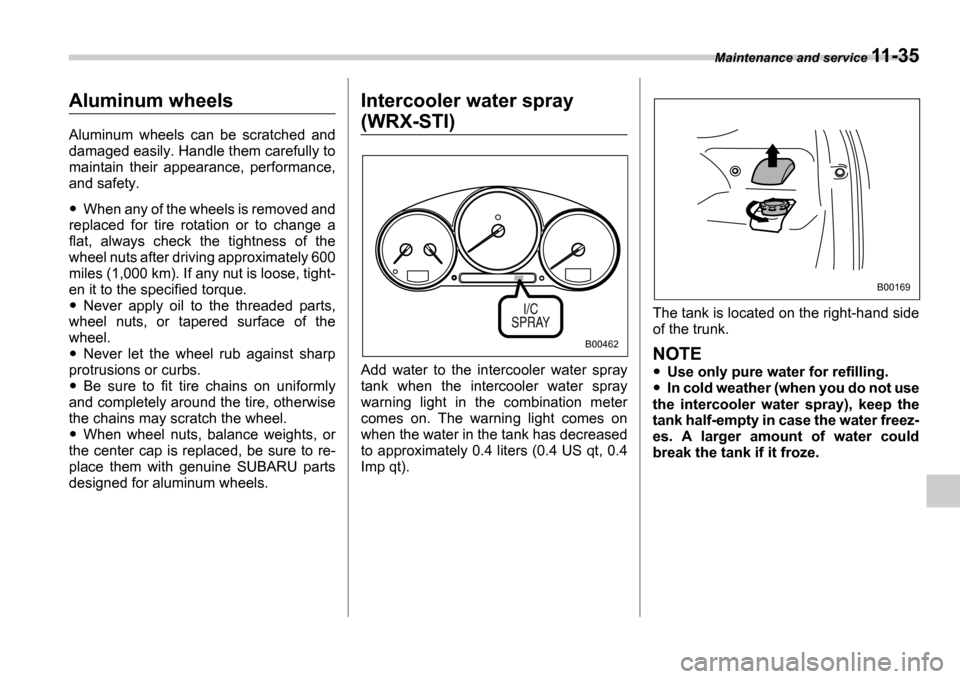
Maintenance and service 11-35
Aluminum wheels
Aluminum wheels can be scratched and
damaged easily. Handle them carefully to
maintain their appearance, performance,
and safety.
When any of the wheels is removed and
replaced for tire rotation or to change a
flat, always check the tightness of the
wheel nuts after driving approximately 600
miles (1,000 km). If any nut is loose, tight-
en it to the specified torque.
Never apply oil to the threaded parts,
wheel nuts, or tapered surface of the
wheel.
Never let the wheel rub against sharp
protrusions or curbs.
Be sure to fit tire chains on uniformly
and completely around the tire, otherwise
the chains may scratch the wheel.
When wheel nuts, balance weights, or
the center cap is replaced, be sure to re-
place them with genuine SUBARU parts
designed for aluminum wheels.
Intercooler water spray
(WRX-STI)
Add water to the intercooler water spray
tank when the intercooler water spray
warning light in the combination meter
comes on. The warning light comes on
when the water in the tank has decreased
to approximately 0.4 liters (0.4 US qt, 0.4
Imp qt). The tank is located on the right-hand side
of the trunk.
NOTE
Use only pure water for refilling.
In cold weather (when you do not use
the intercooler water spray), keep the
tank half-empty in case the water freez-
es. A larger amount of water could
break the tank if it froze.
B00462
B00169
Page 341 of 365
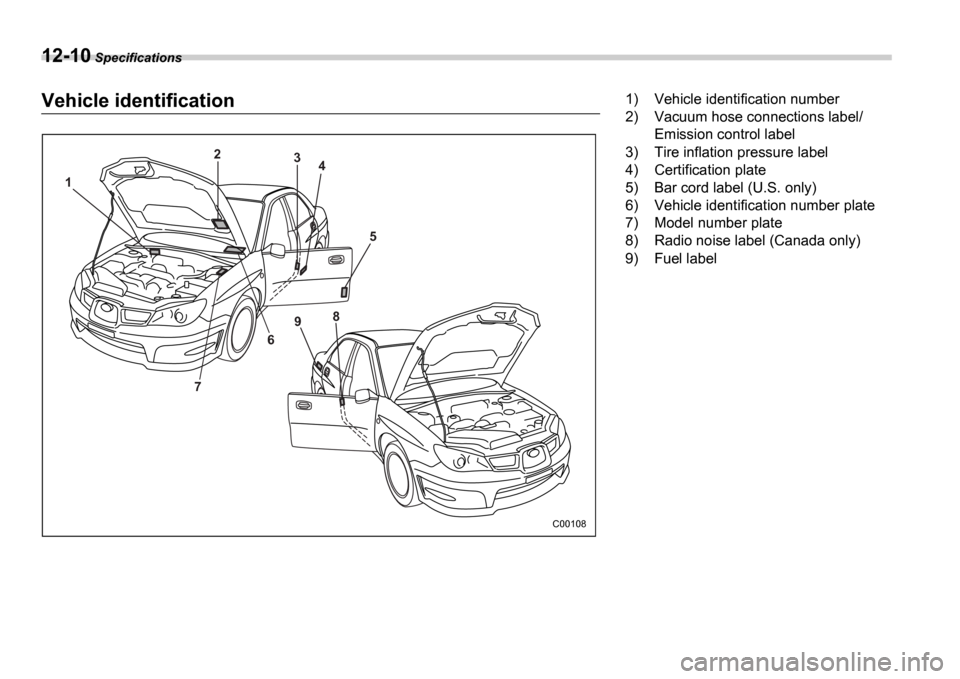
12-10 Specifications
Vehicle identification
1 2
3
4
5
6
7 9
8
C00108
1) Vehicle identification number
2) Vacuum hose connections label/
Emission control label
3) Tire inflation pressure label
4) Certification plate
5) Bar cord label (U.S. only)
6) Vehicle identification number plate
7) Model number plate
8) Radio noise label (Canada only)
9) Fuel label
Page 342 of 365

13
Consumer information and Reporting safety defects
Tire information .................................................. 13-2
Tire labeling ..................................... ........................ 13-2
Recommended tire inflation pressure ............... ... 13-5
Glossary of tire terminology ...................... ............ 13-6
Tire care maintenance and safety practices ..... 13-7
Vehicle load limit how to determine ................... 13-8
Determining compatibility of tire and vehicle load capacities ................................... ................... 13-10
Adverse safety consequences of overloading on
handling and stopping and on tires ................ ... 13-11
Steps for Determining Correct Load Limit .......... . 13-11
Uniform tire quality grading standards ............ 13-12
Treadwear ......................................... ....................... 13-12
Traction AA, A, B, C .............................. .................. 13-12
Temperature A, B, C ............................... ................ 13-12
Reporting safety defects (USA) .................... ..... 13-13
Page 344 of 365
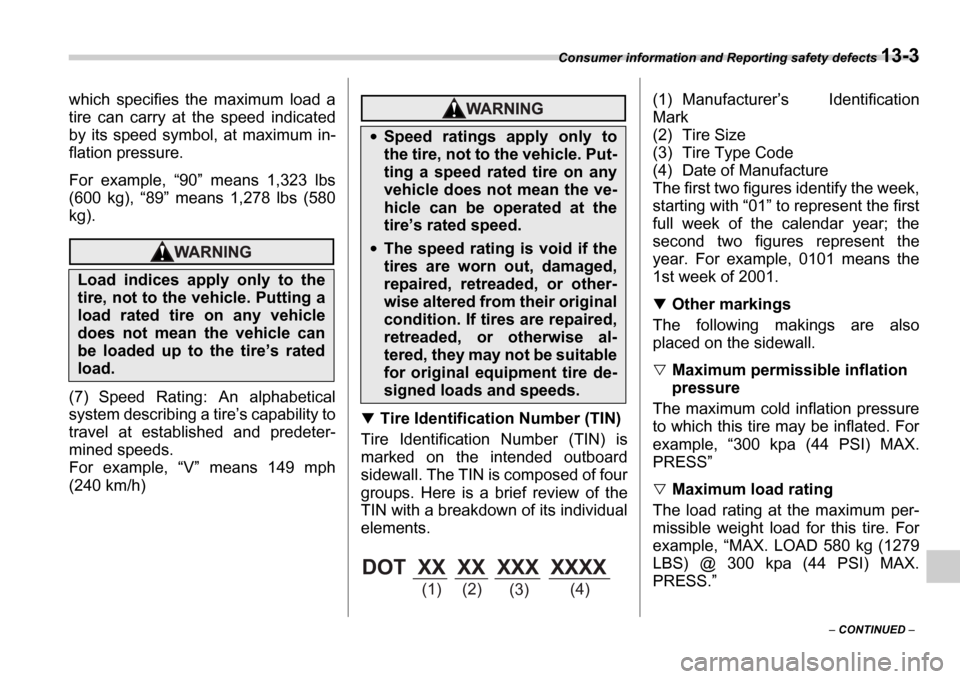
Consumer information and Reporting safety defects 13-3
CONTINUED
which specifies the maximum load a
tire can carry at the speed indicated
by its speed symbol, at maximum in-
flation pressure.
For example,
90 means 1,323 lbs
(600 kg), 89 means 1,278 lbs (580
kg).
(7) Speed Rating: An alphabetical
system describing a tire s capability to
travel at established and predeter-
mined speeds.
For example, V means 149 mph
(240 km/h)
Tire Identification Number (TIN)
Tire Identification Number (TIN) is
marked on the intended outboard
sidewall. The TIN is composed of four
groups. Here is a brief review of the
TIN with a breakdown of its individual
elements. (1) Manufacturer
s Identification
Mark
(2) Tire Size
(3) Tire Type Code
(4) Date of Manufacture
The first two figures identify the week,
starting with 01 to represent the first
full week of the calendar year; the
second two figures represent the
year. For example, 0101 means the
1st week of 2001.
Other markings
The following makings are also
placed on the sidewall.
Maximum permissible inflation
pressure
The maximum cold inflation pressure
to which this tire may be inflated. For
example, 300 kpa (44 PSI) MAX.
PRESS
Maximum load rating
The load rating at the maximum per-
missible weight load for this tire. For
example, MAX. LOAD 580 kg (1279
LBS) @ 300 kpa (44 PSI) MAX.
PRESS.
Load indices apply only to the
tire, not to the vehicle. Putting a
load rated tire on any vehicle
does not mean the vehicle can
be loaded up to the tire s rated
load.
Speed ratings apply only to
the tire, not to the vehicle. Put-
ting a speed rated tire on any
vehicle does not mean the ve-
hicle can be operated at the
tire s rated speed.
The speed rating is void if the
tires are worn out, damaged,
repaired, retreaded, or other-
wise altered from their original
condition. If tires are repaired,
retreaded, or otherwise al-
tered, they may not be suitable
for original equipment tire de-
signed loads and speeds.
DOT XX XX XXX XXXX
(1) (2) (3)(4)
Page 346 of 365
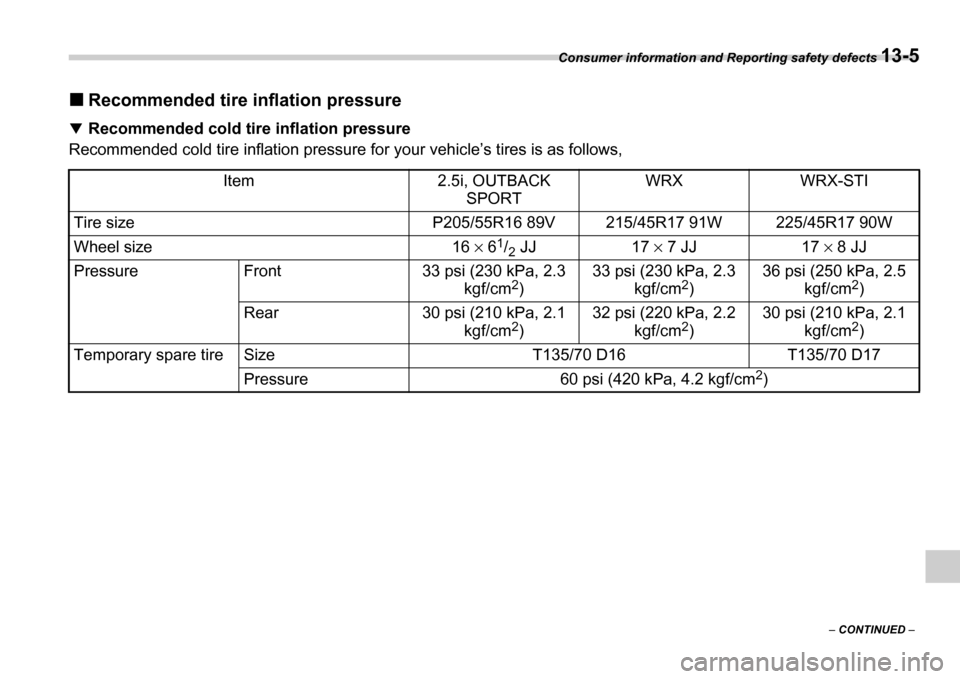
Consumer information and Reporting safety defects 13-5
CONTINUED
Recommended tire inflation pressure
Recommended cold tire inflation pressure
Recommended cold tire inflation pressure for your vehicle s tires is as follows,
Item2.5i, OUTBACK
SPORTWRXWRX-STI
Tire sizeP205/55R16 89V215/45R17 91W225/45R17 90W
Wheel size16 61/2 JJ17 7 JJ17 8 JJ
PressureFront33 psi (230 kPa, 2.3 kgf/cm2)
33 psi (230 kPa, 2.3 kgf/cm2)
36 psi (250 kPa, 2.5 kgf/cm2)
Rear30 psi (210 kPa, 2.1
kgf/cm2)
32 psi (220 kPa, 2.2 kgf/cm2)
30 psi (210 kPa, 2.1 kgf/cm2)
Temporary spare tireSizeT135/70 D16T135/70 D17
Pressure60 psi (420 kPa, 4.2 kgf/cm2)
Page 347 of 365
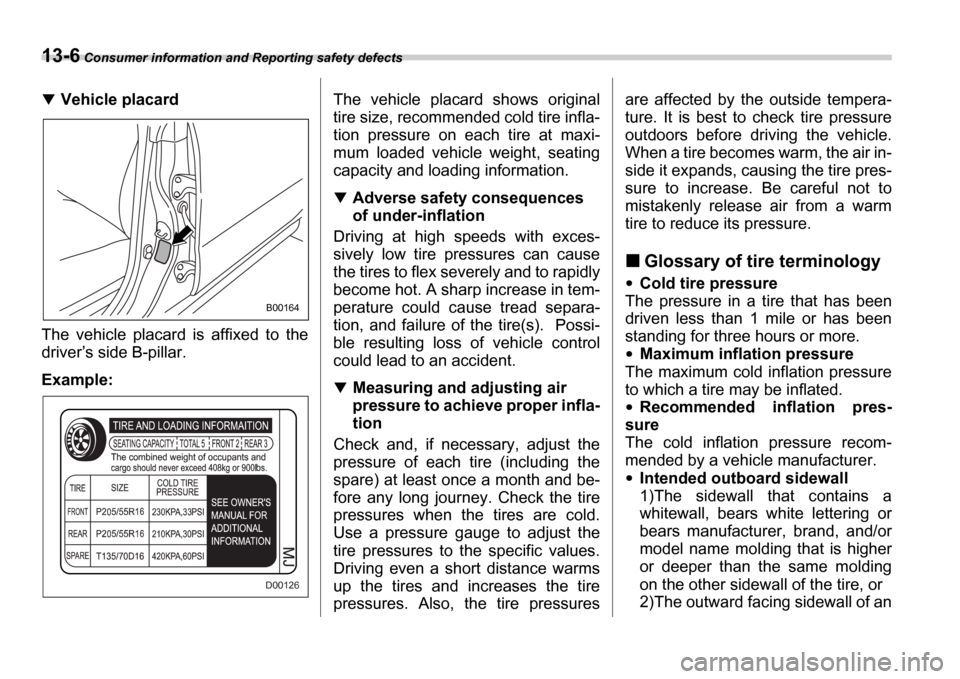
13-6 Consumer information and Reporting safety defects
Vehicle placard
The vehicle placard is affixed to the
driver s side B-pillar.
Example: The vehicle placard shows original
tire size, recommended cold tire infla-
tion pressure on each tire at maxi-
mum loaded vehicle weight, seating
capacity and loading information.
Adverse safety consequences
of under-inflation
Driving at high speeds with exces-
sively low tire pressures can cause
the tires to flex severely and to rapidly
become hot. A sharp increase in tem-
perature could cause tread separa-
tion, and failure of the tire(s). Possi-
ble resulting loss of vehicle control
could lead to an accident.
Measuring and adjusting air
pressure to achieve proper infla-
tion
Check and, if necessary, adjust the
pressure of each tire (including the
spare) at least once a month and be-
fore any long journey. Check the tire
pressures when the tires are cold.
Use a pressure gauge to adjust the
tire pressures to the specific values.
Driving even a short distance warms
up the tires and increases the tire
pressures. Also, the tire pressures are affected by the outside tempera-
ture. It is best to check tire pressure
outdoors before driving the vehicle.
When a tire becomes warm, the air in-
side it expands, causing the tire pres-
sure to increase. Be careful not to
mistakenly release air from a warm
tire to reduce its pressure.
Glossary of tire terminology
Cold tire pressure
The pressure in a tire that has been
driven less than 1 mile or has been
standing for three hours or more.
Maximum inflation pressure
The maximum cold inflation pressure
to which a tire may be inflated.
Recommended inflation pres-
sure
The cold inflation pressure recom-
mended by a vehicle manufacturer.
Intended outboard sidewall
1)The sidewall that contains a
whitewall, bears white lettering or
bears manufacturer, brand, and/or
model name molding that is higher
or deeper than the same molding
on the other sidewall of the tire, or
2)The outward facing sidewall of an
B00164
D00126
Page 348 of 365

Consumer information and Reporting safety defects 13-7
CONTINUED
asymmetrical tire that has a particu-
lar side that must always face out-
ward when mounting on a vehicle.
Accessory weight
The combined weight (in excess of
those standard items which may be
replaced) of floor mats, leather seats
and cross bars to the extent that these
items are available as factory-in-
stalled equipment (whether installed
or not).
Curb weight
The weight of a motor vehicle with
standard equipment including the
maximum capacity of fuel, oil, and
coolant and air conditioning.
Maximum loaded vehicle weight
The sum of curb weight, accessory
weight, vehicle capacity weight and
production options weight.
Normal occupant weight
150 lbs (68 kg) times the number of
occupants (3 occupants).
Occupant distribution
Distribution of occupants in a vehicle,
2 in front, 1 in rear seat.
Production options weight
The combined weight of those in-
stalled regular production options weighing over 5.1 lbs (2.3 kg) in ex-
cess of those standards items which
they replace, not previously consid-
ered in curb weight or accessory
weight.
Vehicle capacity weight
The total weight of cargo, luggage
and occupants that can be added to
the vehicle.
Vehicle maximum load on a tire
Load on an individual tire that is deter-
mined by distributing to each axle its
share of the maximum loaded vehicle
weight and dividing by two.
Vehicle normal load on a tire
Load on an individual tire that is deter-
mined by distributing to each axle its
share of the curb weight, accessory
weight, and normal occupant weight
and dividing by two.
Tire care maintenance and
safety practices
Check on a daily basis that the tires
are free from serious damage, nails,
and stones. At the same time, check
the tires for abnormal wear.
Inspect the tire tread regularly and
replace the tires before their tread wear indicators become visible. When
a tire
s tread wear indicator becomes
visible, the tire is worn beyond the ac-
ceptable limit and must be replaced
immediately. With a tire in this condi-
tion, driving at even low speeds in wet
weather can cause the vehicle to hy-
droplane. Possible resulting loss of
vehicle control can lead to an acci-
dent.
To maximize the life of each tire and
ensure that the tires wear uniformly, it
is best to rotate the tires every 7,500
miles (12,500 km). Rotating the tires
involves switching the front and rear
tires on the right-hand side of the ve-
hicle and similarly switching the front
and rear tires on the left-hand side of
the vehicle. (Each tire must be kept on
its original side of the vehicle.) Re-
place any damaged or unevenly worn
tire at the time of rotation. After tire ro-
tation, adjust the tire pressures and
make sure the wheel nuts are correct-
ly tightened. A tightening torque spec-
ification and a tightening sequence
specification for the wheel nuts can be
found Flat tires section in chapter 9.